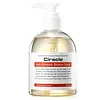What's inside
What's inside
 Key Ingredients
Key Ingredients

 Benefits
Benefits

 Concerns
Concerns

 Ingredients Side-by-side
Ingredients Side-by-side

Water
Skin ConditioningSodium Laureth Sulfate
CleansingGlycerin
HumectantPropylene Glycol
HumectantCocamidopropyl Betaine
CleansingSodium Chloride
MaskingPEG-120 Methyl Glucose Dioleate
EmulsifyingDisodium Laureth Sulfosuccinate
CleansingPhenoxyethanol
PreservativePortulaca Oleracea Extract
Skin ConditioningButylene Glycol
HumectantMelaleuca Alternifolia Leaf Oil
AntioxidantMethylparaben
PreservativeDisodium EDTA
Rhus Semialata Gall Extract
Skin ConditioningSalix Alba Bark Extract
Astringent1,2-Hexanediol
Skin ConditioningSodium Benzoate
MaskingWater, Sodium Laureth Sulfate, Glycerin, Propylene Glycol, Cocamidopropyl Betaine, Sodium Chloride, PEG-120 Methyl Glucose Dioleate, Disodium Laureth Sulfosuccinate, Phenoxyethanol, Portulaca Oleracea Extract, Butylene Glycol, Melaleuca Alternifolia Leaf Oil, Methylparaben, Disodium EDTA, Rhus Semialata Gall Extract, Salix Alba Bark Extract, 1,2-Hexanediol, Sodium Benzoate
Water
Skin ConditioningPropylene Glycol
HumectantDecyl Glucoside
CleansingCocamidopropyl Betaine
CleansingTea-Lauryl Sulfate
CleansingPropanediol
SolventSodium Laureth Sulfate
CleansingDisodium Laureth Sulfosuccinate
CleansingCocamide DEA
EmulsifyingAloe Barbadensis Sprout
HumectantAlgae Extract
EmollientPropolis Extract
Skin ConditioningHamamelis Virginiana Leaf Extract
Skin ConditioningOryza Sativa Bran Extract
Skin ConditioningBoswellia Serrata Extract
Skin ConditioningMel Extract
MoisturisingOligopeptide-10
AntimicrobialPEG-150 Pentaerythrityl Tetrastearate
EmulsifyingGluconolactone
Skin ConditioningDisodium EDTA
Piroctone Olamine
PreservativeSodium Benzoate
MaskingButylene Glycol
HumectantCalcium Gluconate
HumectantCitric Acid
BufferingPotassium Sorbate
PreservativeParfum
MaskingPhenoxyethanol
PreservativeWater, Propylene Glycol, Decyl Glucoside, Cocamidopropyl Betaine, Tea-Lauryl Sulfate, Propanediol, Sodium Laureth Sulfate, Disodium Laureth Sulfosuccinate, Cocamide DEA, Aloe Barbadensis Sprout, Algae Extract, Propolis Extract, Hamamelis Virginiana Leaf Extract, Oryza Sativa Bran Extract, Boswellia Serrata Extract, Mel Extract, Oligopeptide-10, PEG-150 Pentaerythrityl Tetrastearate, Gluconolactone, Disodium EDTA, Piroctone Olamine, Sodium Benzoate, Butylene Glycol, Calcium Gluconate, Citric Acid, Potassium Sorbate, Parfum, Phenoxyethanol
 Reviews
Reviews

Ingredients Explained
These ingredients are found in both products.
Ingredients higher up in an ingredient list are typically present in a larger amount.
Butylene Glycol (or BG) is used within cosmetic products for a few different reasons:
Overall, Butylene Glycol is a safe and well-rounded ingredient that works well with other ingredients.
Though this ingredient works well with most skin types, some people with sensitive skin may experience a reaction such as allergic rashes, closed comedones, or itchiness.
Learn more about Butylene GlycolCocamidopropyl Betaine is a fatty acid created by mixing similar compounds in coconut oil and dimethylaminopropylamine, a compound with two amino groups.
This ingredient is a surfactant and cleanser. It helps gather the dirt, pollutants, and other impurities in your skin to be washed away. It also helps thicken a product and make the texture more creamy.
Being created from coconut oil means Cocamidopropyl Betaine is hydrating for the skin.
While Cocamidopropyl Betaine was believed to be an allergen, a study from 2012 disproved this. It found two compounds in unpure Cocamidopropyl Betaine to be the irritants: aminoamide and 3-dimethylaminopropylamine. High-grade and pure Cocamidopropyl Betaine did not induce allergic reactions during this study.
Learn more about Cocamidopropyl BetaineDisodium EDTA plays a role in making products more stable by aiding other preservatives.
It is a chelating agent, meaning it neutralizes metal ions that may be found in a product.
Disodium EDTA is a salt of edetic acid and is found to be safe in cosmetic ingredients.
Learn more about Disodium EDTAThis ingredient is a cleansing agent, surfactant, and foam booster. It considered an alternative to traditional sulfates (Sulfosuccinate) and is allowed in "sulfate-free" products.
According to a manufacturer, this ingredient is mild and can be used in baby and bath options.
Phenoxyethanol is a preservative that has germicide, antimicrobial, and aromatic properties. Studies show that phenoxyethanol can prevent microbial growth. By itself, it has a scent that is similar to that of a rose.
It's often used in formulations along with Caprylyl Glycol to preserve the shelf life of products.
Propylene Glycol is an odorless, colorless liquid. As a humectant, it helps skin retain moisture. It also aids in delivering active ingredients.
Another role of this ingredient is preventing a product from melting or freezing. Propylene glycol also adds antimicrobrial properties to a product, elongating product lifespan.
This ingredient is considered an organic alcohol and commonly added into both cosmetics and foods.
Those with sensitive skin or conditions may develop a rash when using this ingredient.
Learn more about Propylene GlycolSodium Benzoate is a preservative. It's used in both cosmetic and food products to inhibit the growth of mold and bacteria. It is typically produced synthetically.
Both the US FDA and EU Health Committee have approved the use of sodium benzoate. In the US, levels of 0.1% (of the total product) are allowed.
Sodium benzoate works as a preservative by inhibiting the growth of bacteria inside of cells. It prevents the cell from fermenting a type of sugar using an enzyme called phosphofructokinase.
It is the salt of benzoic acid. Foods containing sodium benzoate include soda, salad dressings, condiments, fruit juices, wines, and snack foods.
Studies for using ascorbic acid and sodium benzoate in cosmetics are lacking, especially in skincare routines with multiple steps.
We always recommend speaking with a professional, such as a dermatologist, if you have any concerns.
Learn more about Sodium BenzoateSodium Laureth Sulfate (SLES) is a foaming, cleansing, and emulsifying ingredient. It is created from palm kernel oil or coconut oil. SLES is not the same as sodium lauryl sulfate. It is much milder and less likely to irritate.
SLES helps create foam in personal products. It also prevents ingredients from separating, helping to elongate the shelf life.
Sodium Laureth Sulfate is a type of sulfate. It can be drying. We recommend speaking with a professional about using this ingredient if you have concerns.
Learn more about Sodium Laureth SulfateWater. It's the most common cosmetic ingredient of all. You'll usually see it at the top of ingredient lists, meaning that it makes up the largest part of the product.
So why is it so popular? Water most often acts as a solvent - this means that it helps dissolve other ingredients into the formulation.
You'll also recognize water as that liquid we all need to stay alive. If you see this, drink a glass of water. Stay hydrated!
Learn more about Water